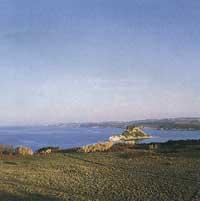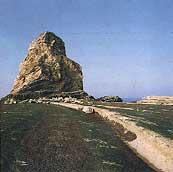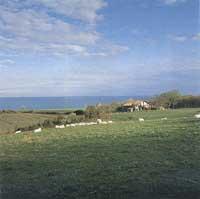Protection of the coast
The ecological aspect, of course, is a fundamental element to take into account, even if it is not the only one. The advance of the sciences, and especially of biology and ecology, allows us to know better the quality and originality of these spaces of interaction between the earth and the sea: an extraordinary primary productivity; plant species and original animals, sometimes endemic, often very rare and on the way of extinction, with international interest in the conservation of the genetic heritage of the world of living beings, in front of the coastal intervention of man that aggravates some natural phenomena (also it is necessary to take into account the role of erosion).

However, in addition to the ecological value, the free spaces that still remain on the coast are a privileged place for their cultural development. There are many artists, writers and musicians who have inspired our coast. The disaster of natural spaces, before or after, reduces the cultural heritage.
In addition, the relationship with nature is an increasingly appreciated social need. Those who have escaped from the villages and become inhabitants of the cities, thank enormously the variety of coastal spaces before uniform landscapes of the cities. Therefore, it is no surprise that people find themselves in the sea for walks and holidays.
We cannot forget, on the other hand, the primary importance of the coast from an economic point of view, especially in terms of tourism and the exploitation of marine resources, since their possibilities are unique. In both areas, it is increasingly evident that the protection of the marine environment is a decisive element to preserve and develop this economic potential. The quality and abundance of coastal landscapes are essential for tourist development and fishing activities and marine crops also need protected areas.
So far we have justified in various ways the need to protect the nature of the coasts, albeit briefly, and now we need to underline the need for a true territorial policy.
Conservation of the coast: fertile road

When economic reasons require analyzing the volume and distribution of public expenditures, and in the face of the proliferation of laws and regulations accumulated for years in urban planning and protection of the environment, it should be asked whether the budgetary cost of forming the public heritage of natural land on the coast is not a luxury without benefits.
This doubt, despite its apparent legitimacy, discards three fundamental data shown by experience:
- The first of these is that the regulations, even the most elaborate ones, have limitations and have to be reinforced.
- The second, more than the establishment of regulations, is the management of these spaces, which in many cases can only be carried out through the ownership of the soil.
- The third, that the most beautiful environments are open to all, is, in most cases, that they can only be achieved with them.
* Reinforcement of conventional regulations
For a few years, in the area of conservation of nature, a huge arsenal has been formed. The old legislation of the French State of Media of 1930, the system of sensitive perimeters, the plans of occupation of the soil and, more recently, the Law of 3 January 1986, which includes the principle of prohibition of building in areas not urbanized from the coast until 100 m, have been overlapped, to mention only the main weapons existing in the coast to prevent urbanizations.

Although in most cases these measures are sufficient to obtain the desired result (avoid their construction in some areas), it should be noted that they will never guarantee sustainable protection.
Therefore, we are faced with the following question: for example, knowing that on the coast is between two poles of urban development and that there are (or will exist) great pressures to achieve its urbanization, from the moment it is decided to conserve an ecologically and landscaped environment remarkable, is there any measure that ensures total protection?
The lack of affirmative response to this question necessarily leads us to the measure of the public appropriation of the medium and this is the first justification of the objectives of the Conservatoire de l'Espace littoral et des Rivages lacustres of the Conservatory of Coastal Zones and Lacubazterres.
* Buy to manage
The second data for the argument of the territorial policy that will complete the policy of protection is derived from the consideration of the management needs.
The protection of natural means should not be limited only to certain prohibitions, not even to certain duties. In most cases a real management is necessary: care, cleaning, planting in forests, etc. They must be done.
And it is that the dog of many owners always is hungry.
* The best places open to all

The conservation of the natural coastal spaces is justified only taking into account the aforementioned cultural and social demands, if it is possible to keep open the most beautiful places for all. What would, for example, serve the collection of masterpieces of our artistic heritage at the Bilbao Museum of Fine Arts if that museum were closed? The same is true of environments. How can you really justify the policy of the regulations that protect them, even if it is the most sophisticated, if those unique protected spaces are private properties to which access to the public is forbidden?
To explain the need for a policy of access to the most beautiful natural landscapes of the coast, the reason is that, although there is no urbanizing pressure or degradation that requires a certain management, the only possible way is the public ownership of the land, so that some large places remain open to all and comply with what we can define as a true right to nature.
Through local communities
The Conservatory is an institution that has a budget fed annually by subsidies granted by the French State. However, despite its state character, the Conservatory has a very decentralized organization and functioning.
Protection programmes and acquisition projects are systematically analysed by the Shore Councils (Conseils de Rivage). These commissions are eight: Manchego, North Sea, Atlantic, Mediterranean, Lakes, Kortsika, French coasts of America and French coasts of the Indian Ocean.
Each Council of Uralde is represented by the President and one of its members in the Administrative Board of the Conservatory.
The Board of Directors is the one that has the last word when deciding the purchases to be made. The representatives of the State, who defend the views of the corresponding administration, are not a majority in the Administrative Board. Half of its members are elected (deputies, senators, representatives of the Councils of Ribera) and four representatives of associations for the protection of nature and the environment.

Each decision of the Administrative Board is a consequence of a long debate of ideas and views.
No land can be acquired without obtaining the prior opinion of all interested Municipal Councils. In the case that the municipality has a contrary opinion, the Conservatory is in the hands of trying to make the Municipality have a favorable opinion or in some cases, even though it has not been habitual, to avoid that opinion contrary to the municipality.
The set of provisions of the Law of 10 July 1975, by which the Conservatory is created, makes the responsibility of the protection to fall on the local communities, municipalities and affected departments. For the Conservatory guarding absolutely inviolable standards, these provisions are the best tool for long-term success.
Conservation, active verb
Therefore, the grounds of the Conservatory that escape the urbanization are open to the public and require a management that requires a special attention.
Before acquiring any land, the Conservatory carries out an ecological balance of the environment, defines areas of biological and landscape interest and analyzes the factors that threaten the ecosystem. In some cases, without jeopardizing the richness of natural space, to the extent that it improves it, the implementation and development of agricultural, pastoralist and fishing activities can be foreseen.
According to this ecological expert report, an authentic balance of land health, a program of preparation and protection of environments is carried out.
After carrying out these works, the Conservatory maintains management agreements with the local groups (municipalities and unions of municipalities) affected, the National Office of Montes and, eventually, with the associations dedicated to the protection of the environment. Thus, protected lands are not closed museums.
It depends on yourself to discover the nature that is offered to you, to learn to walk, to silence, to listen, to understand, to love and, in short, to respect the places that you like to see and to travel.
Abbadia, protected environment

Antoine Abbadia, who certainly understood better the needs of the future than the rest, tried to foresee measures to preserve the region he created. This area was formed by 340 hectares between Hendaia and San Juan de Luz, where he built a castle. In the donations he made in his last days, he imposes to the Academy of Sciences a series of obligations to maintain it, all based on his concern for nature and the attention and respect he deserved.
Three quarters of a century later, in October 1979, in the framework of the agreement signed with the Academy of Sciences by the Conservatory of Coastal Media and Lacubazterres, what was left of the initial property, with the exception of the castle, was recovered, and today continues its conservation.
Its 46 hectares, of which 15 are forests, are witness to what was the Basque coast. Many hendayes believe it is a true treasure, the coast of the Basque Country North, one of the most urbanized in the French state. Of the 38 km that the department of the Atlantic Pyrenees has, only 4% are natural spaces.
In 1981 the city of Hendaia signed a management agreement with the Conservatory of Coasts. Since then he is responsible for its maintenance, care and even recovery. The region of Abbadia can be considered a symbol of protection success, but there is still much to do: Between Hendaia and Ziburu, in the municipality of Urruña, there are wide undulating fields of “Erlaize”.
In order to guarantee the preservation of the environment assigned by the Conservatory to Abbadia, the Conservatory aims to reach in the area classified about 200 hectares.
At the end of 1992, 40,350 hectares were obtained in 305 sites. 543 km of French coast have been protected and managed, becoming accessible to the public. Very close to us, in Aquitaine, the Conservatory of Coasts covers in about fifteen places more than 2,000 hectares. Highlights to visit: A few kilometers north of Baiona, in 777 hectares of the Marais d´Orx there are more than 200 species of birds (thousands of ducks and geese, cranes, unique marine eagles, etc. ). ). |

Buletina
Bidali zure helbide elektronikoa eta jaso asteroko buletina zure sarrera-ontzian











